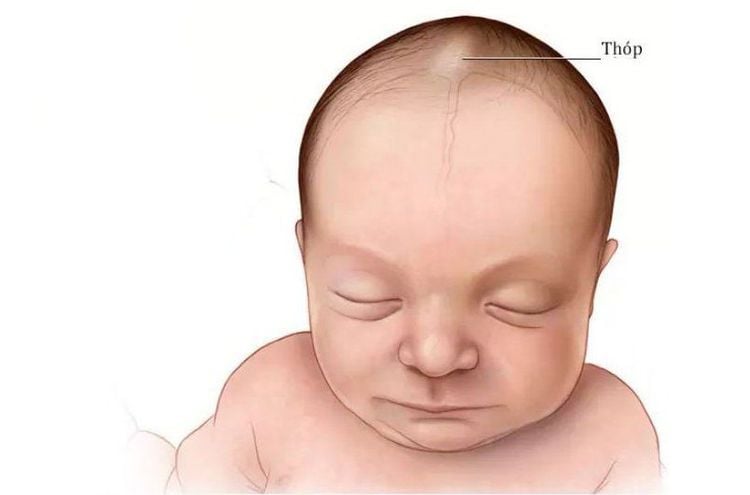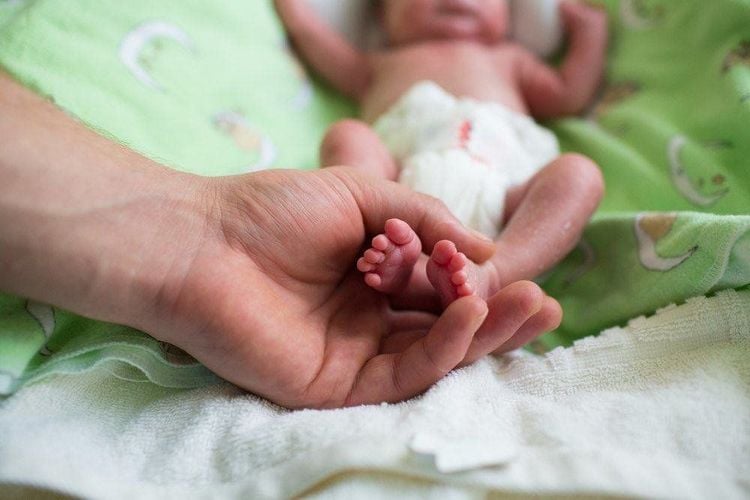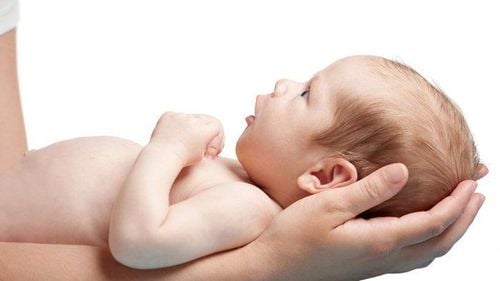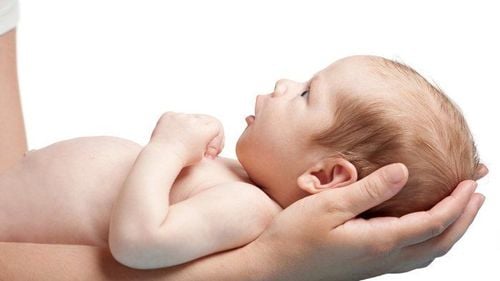This is an automatically translated article.
Posted by Master, Doctor Nguyen Thi An - Department of Pediatrics - Neonatology - Vinmec Ha Long International General Hospital
Although the fontanelle occupies only a small area of the body, the changes of the fontanel reflect the baby's body condition. When a baby is born, there are 2 fontanels on his head: anterior fontanel and posterior fontanelle.
1. What are the characteristics of the fontanelle in a newborn?
Before the baby is born, there are 6 fontanels on the head: 1 anterior fontanel, 1 posterior fontanelle, 2 bony fontanelles located in the temporal region and 2 occipital fonts located at the corner behind the child's ear. However, the 4 small fontanels in the temples and occipital bones are very small and they will close before the baby is born. When a baby is born, there are 2 fontanels on his head: anterior fontanel and posterior fontanelle.
Structurally and functionally, the fontanelle has a fibrous membrane structure that holds the bones of the head together, and is an elastic joint between the bones of the skull. It is thanks to these fibrous membranes that the baby's head can easily change its size and shape to suit the mother's vaginal tract to make it easier for the baby to 'come out'.
On the other hand, when the baby is born, the fontanelle also acts as a 'cushion' to protect the baby's brain from external shocks when the baby falls.
Infant fontanel size Newborn fontanel: When a baby is just born, the baby's posterior fontanel is about 0.5cm in size and usually closes when the baby is 2-3 months old.
Infant fontanelle: The size of the front fontanelle often changes very quickly and a lot. At birth, the anterior fontanelle has an average size of about 2.1cm, but can vary from 0.6 to 3.6cm depending on the baby.

During the first few months, the fontanelles of the baby can change and the fontanel closure time is not fixed, most of the newborn fontanels will close when the baby is 14-15 years old, allow until 18 months of age. .
The fontanelle rises and falls according to the pulse of the blood vessels, when the child eats and sleeps normally, it is a completely normal phenomenon of the child.
Trắc nghiệm: các chỉ số cần chú ý về sự phát triển thể chất của trẻ
Chiều cao, cân nặng của bé ở từng giai đoạn nên là bao nhiêu là bình thường, bao nhiêu là bất thường? Cùng ThS.BS Ma Văn Thấm điểm lại xem bạn đã nắm được các chỉ số phát triển thể chất của bé chưa nhé!The following content is prepared under supervision of Thạc sĩ, Bác sĩ y khoa, Ma Văn Thấm , Nhi , Phòng khám Đa khoa Quốc tế Vinmec Dương Đông(Phú Quốc)
2. Baby fontanel bulge: When is it abnormal?
Newborn fontanelle will change continuously until it is complete. When children are normal, mothers should feel their baby's fontanelle to know the characteristics of their baby's fontanelle, normally the baby's fontanel can be flat, slightly sunken or a little fuller. If in the process of taking care of a child, you see unusual changes in the fontanelle like the one below, you need to pay close attention.
Baby fontanelle bulge If the mother sees the infant's fontanelle bulging, refuses to breastfeed, the baby cries abnormally, with or without fever, strong vomiting, convulsions, blue skin, then the mother should take the baby to the hospital immediately, because the baby may have encephalitis, meningitis, brain-meningeal hemorrhage or some other disease that causes increased pressure in the brain.
Baby fontanelles sunken For babies with sunken fontanels, it is mostly due to acute dehydration due to long-term diarrhea, vomiting, high fever, excessive sweating, poor appetite for a long time. .. Besides, the baby may also suffer from severe malnutrition, rapid weight loss due to inadequate absorption of calcium and vitamins necessary for the body.

Newborn fontanel is too wide This case often occurs in newborn babies and is more common in babies with rickets. Too wide an infant's fontanelle will adversely affect the child's brain, not protecting the brain inside.
Infant fontanelle too small If the fontanelle is too small, it will cause the baby's head to be malformed due to the narrowing of the crown, affecting the baby's brain development later on.
Infant fontanels close prematurely Neonatal fontanelles close prematurely can be due to many reasons such as: congenital, early ossification of the brain or skull or maternal exposure to X-rays for a long time and the consequences of this It hinders brain development and reduces children's intelligence.
Late closing fontanelle in children shows the possibility of slow bone ossification for poor thyroid function or vitamin D deficiency in children with rickets, malnutrition, or even abnormal brain enlargement.
For cases in which the child is after 2 years old but still has anterior fontanelle, parents should take the child to a doctor for a specific examination and evaluation.
3. How to take care of a newborn's fontanelle?
Many parents often protect their newborn's fontanelle by wearing a hat for the first few days after birth or when the weather turns cold, this is a very good thing to do to help keep the baby's body temperature.
However, wearing a baby fontanelle will not be directly related to the fontanel protection and keeping the brain warm. Because in the skeleton of the head, the baby's brain is always 'incubated' with a special fluid, called cerebrospinal fluid, to help the brain keep its temperature balance and protect the brain when there is an injury.
Therefore, the best way to care for and protect the fontanelles of the newborn is:
Mothers can use oil to keep warm Take the child to see a doctor to supplement vitamin D and calcium when necessary Prevent rickets by Let the children sunbathe in the morning. Do not sunbathe between 10 am and 2 pm because it will harm the baby's skin. Do not give solid foods to children too early. When children reach the age of solid foods, they should eat enough nutrients. Pay attention not to put sharp objects. touching the fontanelle Keep clean: Bath, wash hair with a soft towel, rub gently, do not touch the fontanel strongly, but also should not be too abstain (don't dare to wash the fontanel) easy to cause dermatitis In short, fontanelle Newborn is a part of the body, the fontanel has a very important function especially in the first months of a child's life. If you observe the above abnormalities in your baby's fontanel every day, you should take your baby to see a doctor for a specific examination.
Vinmec International General Hospital with a system of modern facilities, medical equipment and a team of experts and doctors with many years of experience in neurological examination and treatment, patients can completely peace of mind for examination and treatment at the Hospital.
To register for examination and treatment at Vinmec International General Hospital, you can contact Vinmec Health System nationwide, or register online HERE.
MORE
Infant fontanel: What to know Newborn fontanelle When will the fontanelle be full?














